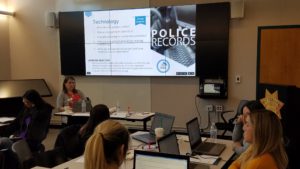September 2020
Ed Claughton, President
PRI Management Group
These are disruptive times and the volume of information coming in is steadily increasing while budget constraints are forcing cost saving measures. Once again, public safety professionals are being asked to “do more with less.” All the leading indicators across the nation are pointing toward a shrinking public safety budget. Agency leaders are going to be faced with tough choices and there is no easy solution. This is not necessarily a bad thing. Knowing what is on the horizon gives us the ability to prepare.
“If you always do what you’ve always done, then you will always get what you’ve always got”
Albert Einstein/Henry Ford
DIGITAL TRANSFORMATION
Technology enables working smarter, not harder. But so does good business process. You likely have heard about digital transformation and there are all kinds of fancy definitions of what it is. We like to keep it simple. As it relates to records operations, it is positioning your agency to operate in a digital environment, wherein not only are your records electronic, but so too are all the touchpoints of information. It is managing agency information from start to finish electronically; enabling the public to contact you electronically; sending and receiving records electronically; signing records electronically; maximizing the use of the information in your records, electronically.

When tackling a project such as this, think of it in terms of a marathon instead of a sprint. True digital transformation involves the organization moving to a digital mindset. This means everything and everyone is involved in the process and everyone contributes to managing agency information more efficiently.
PREPARE FOR ACTION
What areas in your process are redundant? What steps are repetitive or, could be done away with altogether. Why print out a Word document for filling in with a pen? Why scan those records when they should be saved as an electronic record in the first place? Inventory each and every workflow and identify those which could be eliminated or converted to a digital process. And as I’ve said too many times…stop printing reports to create case files.
Keep in mind that digitization is a moving target. New and innovative technologies are continually being developed, refined and improved upon. This isn’t a one-time fix, but rather a mindset of constant process improvement.
Once you’ve defined the process, targeted chokepoints and identified areas to increase efficiency, you can start to develop an overall transformation strategy.
IMPLEMENT IT
Making a change for the sake of efficiency is good, but it is not enough. We need to include decision makers and key stakeholders and let them know why this is important to them as well. This is easier said than done. If you were the chief decision maker, it would be easy. If you’re not that person, then here is a starting point. It’s a matter of buy-in and demonstrating benefit.

People often ask in our training, “how do I convince the bosses that this is important”. I can’t answer that question; but you can. If you own the operation and invest in its future the answer will become quite apparent. Take a look around. Take stock of how things are being done today. It’s 2020. If your department hasn’t changed, it’s time.
Read about our services and how they can help you modernize your operations.
